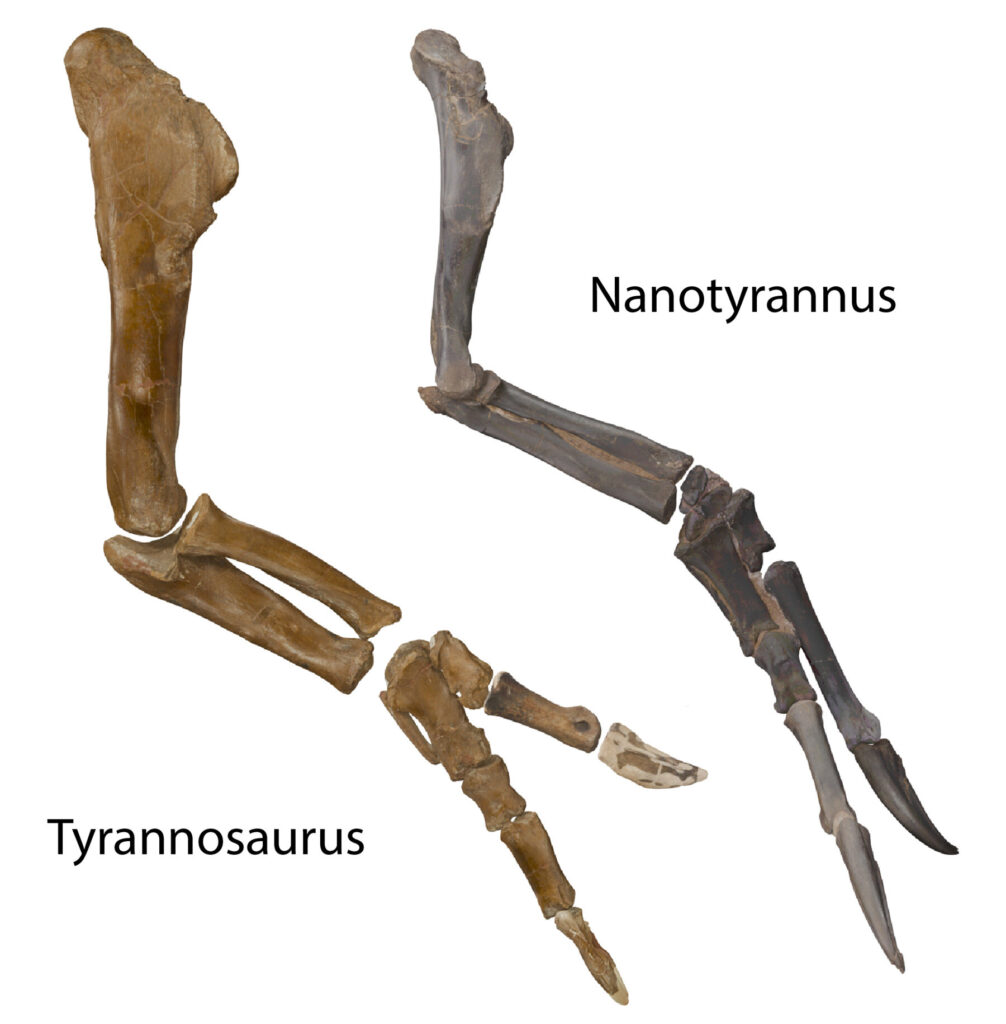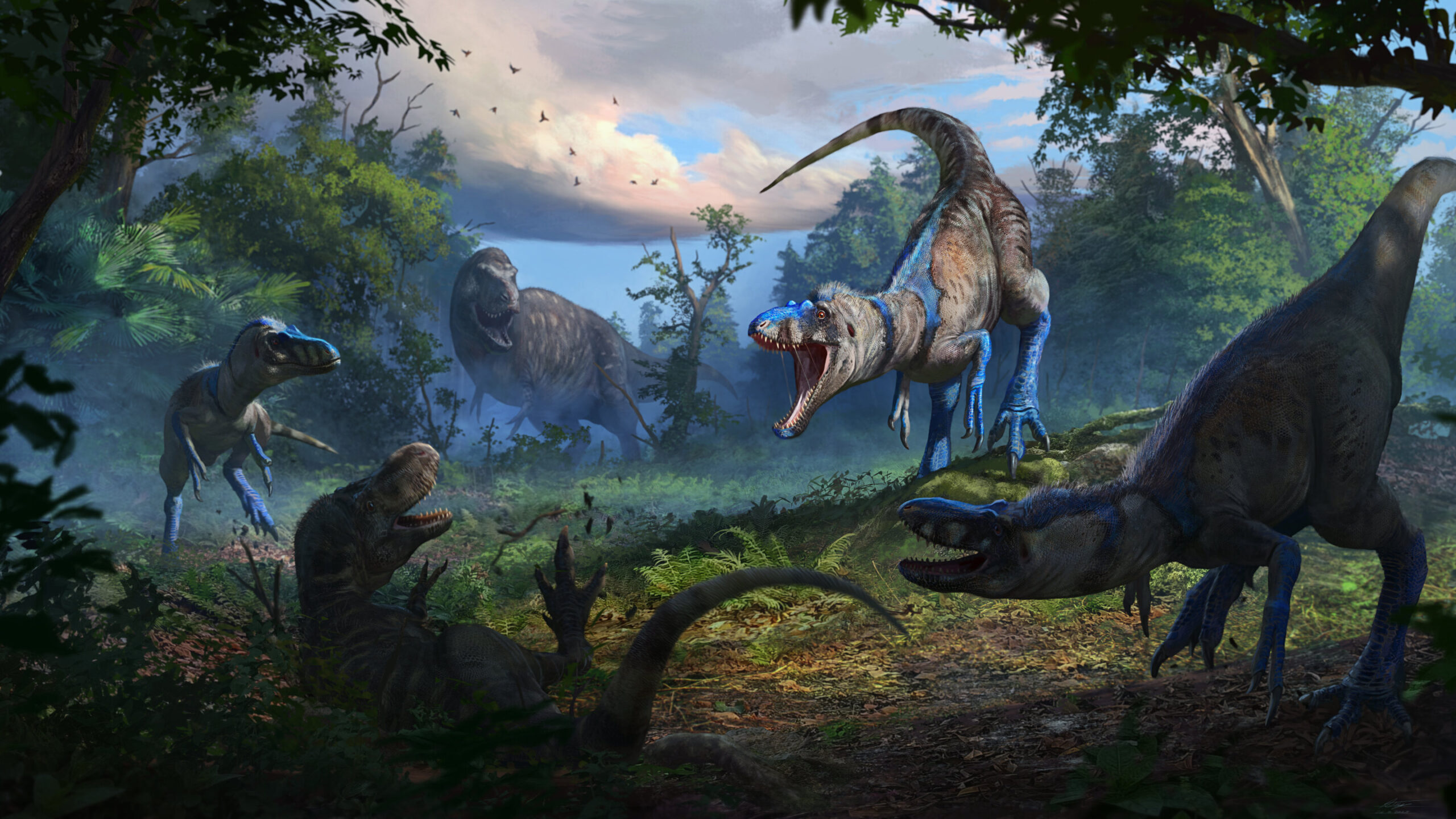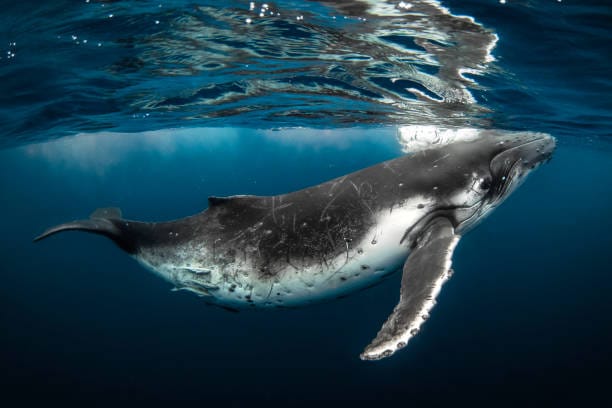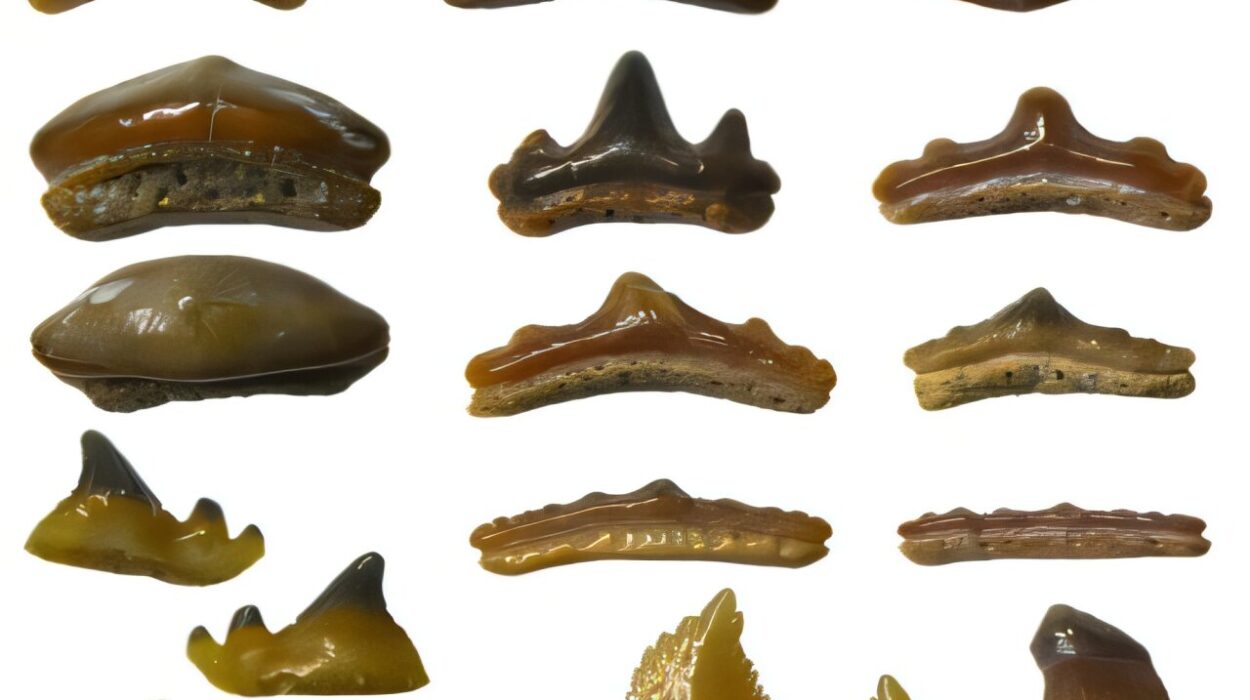For more than half a century, paleontologists have wrestled with one of the most tantalizing questions in dinosaur science: was Nanotyrannus a real species, or just a teenage Tyrannosaurus rex? The debate divided researchers, sparked fierce academic rivalries, and shaped how we understood the evolution of the most famous predator that ever lived.
Now, a breathtaking discovery from the badlands of Montana has finally ended that debate—and upended decades of scientific assumptions. The find doesn’t just rewrite a chapter of dinosaur history. It forces us to rethink what it means to grow up as a tyrant king.
Locked in Combat for 67 Million Years
The fossil at the heart of this revelation is part of the legendary “Dueling Dinosaurs,” a pair of nearly complete skeletons—one a Triceratops, the other a small-bodied tyrannosaur—found together as if frozen mid-battle. Their death scene, preserved in stone for 67 million years, captures an ancient struggle that neither combatant survived.
But the tyrannosaur in this fossil wasn’t what many thought it was. For years, paleontologists assumed it was a juvenile T. rex, a gangly adolescent on its way to becoming the planet’s most fearsome predator. Yet, after years of meticulous research, a team led by Lindsay Zanno of North Carolina State University and James Napoli of Stony Brook University has shown that this assumption was wrong. The small tyrannosaur wasn’t a young T. rex at all—it was an adult Nanotyrannus lancensis.
Their study, published in Nature, represents one of the most significant shifts in paleontology in decades.
The Tyrant’s Smaller Cousin
To reach their conclusion, Zanno, Napoli, and their team turned to the most telling evidence of all: the bones themselves. Using microscopic analysis of growth rings—similar to counting tree rings—they found that the Nanotyrannus specimen was around 20 years old when it died, far past the growth stage of a juvenile.
Even more striking, its skeletal anatomy told a completely different story from T. rex. The creature had longer, more muscular arms, a higher tooth count, and a lighter frame. Its skull contained distinct nerve canals and proportions unlike any T. rex ever found. It also had fewer tail vertebrae and fused spinal elements consistent with physical maturity.
“For Nanotyrannus to be a juvenile T. rex, it would need to defy everything we know about vertebrate growth,” Napoli explained. “It’s not just unlikely—it’s impossible.”
This evidence leaves little doubt: Nanotyrannus was a separate species—a close cousin of T. rex, but one with its own evolutionary path and predatory strategy.
A Clash of Giants—and Ideas
The confirmation of Nanotyrannus as a distinct species overturns decades of scientific consensus. For years, paleontologists had believed that T. rex went through an extreme adolescent phase, growing rapidly from a lithe, fast hunter into a bone-crushing giant. Many smaller tyrannosaur fossils—some with features that didn’t quite fit—were assumed to be teenagers caught mid-growth.
That assumption shaped entire models of T. rex biology. Scientists used those “teenage” fossils to estimate how fast the species grew, how it hunted, and how it changed behavior over time. But now, it turns out that many of those fossils didn’t belong to T. rex at all.
“This fossil doesn’t just settle the debate,” said Zanno. “It flips decades of T. rex research on its head.”
If Nanotyrannus truly coexisted with T. rex, it means that North America in the late Cretaceous wasn’t ruled by a single tyrant. It was a dynamic, competitive ecosystem where multiple apex predators stalked the same prey.
Rewriting the Last Chapter of the Cretaceous
The discovery of an adult Nanotyrannus fundamentally changes how scientists picture the closing moments of the Age of Dinosaurs. Instead of a landscape dominated by a single super-predator, it now appears that the last million years before the asteroid impact were far more diverse and dangerous than anyone imagined.
Zanno’s team examined more than 200 tyrannosaur fossils to trace the distinctions between T. rex and Nanotyrannus. Their analysis revealed that there may have been not one, but two species of Nanotyrannus living alongside T. rex.
One of these new species, they announced, has been named Nanotyrannus lethaeus. The name, drawn from the River Lethe in Greek mythology—the river of forgetfulness—symbolizes how the species was “hidden in plain sight” for decades, misidentified and overlooked.
The existence of N. lethaeus suggests that late Cretaceous ecosystems were teeming with evolutionary experimentation. Tyrannosaurs weren’t following a single path toward gigantism. Some, like T. rex, evolved into massive, heavy-set predators built for overpowering prey with brute force. Others, like Nanotyrannus, took a different route—favoring speed, agility, and precision.
The Anatomy of a Forgotten Predator
While T. rex loomed up to 40 feet long and weighed nearly nine tons, Nanotyrannus was a much leaner hunter. Adults measured around 20 feet long and likely weighed under a ton. Its long legs and narrow frame indicate it was built for speed, perhaps capable of sprinting down smaller prey that larger predators couldn’t catch.
Its arms—larger and more flexible than T. rex’s famously stubby limbs—suggest that it used them in hunting or grappling. Its skull, lined with dozens of sharp teeth, reveals a slicing bite rather than the bone-crushing power of T. rex.

In essence, Nanotyrannus was the cheetah to T. rex’s lion: smaller, faster, and no less deadly.
“This discovery paints a richer, more competitive picture of the last days of the dinosaurs,” said Zanno. “With enormous size, a powerful bite, and stereoscopic vision, T. rex was a formidable predator—but it did not reign uncontested. Darting alongside was Nanotyrannus, a leaner, swifter, and more agile hunter.”
Revisiting a Century-Long Mystery
The story of Nanotyrannus began almost a century ago, when paleontologist Charles W. Gilmore described a small tyrannosaur skull found in Montana and named it Gorgosaurus lancensis. Later, in the 1980s, it was reclassified as Nanotyrannus lancensis—the “dwarf tyrant.”
But as more juvenile T. rex fossils were discovered, many paleontologists began to doubt Nanotyrannus’s validity. The differences, they argued, were simply the result of age. Young T. rex individuals had different proportions and bone structures that changed as they matured.
That argument held sway for decades—until the Dueling Dinosaurs came along. Their exceptional preservation offered something that no previous fossil could: a complete skeleton, with microscopic bone growth patterns intact. For the first time, scientists could measure exactly how old the animal was—and those measurements left no room for ambiguity.
Lessons from the Dueling Dinosaurs
Beyond resolving the identity of Nanotyrannus, the Dueling Dinosaurs fossil offers an intimate glimpse into ancient behavior. The positioning of the two skeletons suggests that the Nanotyrannus may have attacked the Triceratops, only for both to perish in the struggle—perhaps buried by a sudden mudslide or flood.
Their intertwined bones are not just a scientific treasure, but a poignant reminder of life and death in the Cretaceous. Two adversaries, locked together forever, have become storytellers of evolution, ecology, and survival.
The fossil also underscores how much the field of paleontology has advanced. Modern tools—CT scanning, microstructure analysis, 3D modeling—allow scientists to uncover details invisible to the naked eye. With these methods, even ancient bones can reveal secrets once thought lost to time.
A New Era of Discovery
The confirmation of Nanotyrannus opens new doors in dinosaur research. It means that scientists must revisit previous T. rex studies to correct for misidentified specimens. Growth models, behavioral reconstructions, and even theories of T. rex social behavior will need reevaluation.
It also raises the exciting possibility that other “juvenile” specimens of large dinosaurs might turn out to be undiscovered species. If Nanotyrannus could hide in plain sight for decades, what else might the fossil record be keeping from us?
In paleontology, certainty is rare. Every new discovery has the potential to shift the ground beneath long-held theories. Yet, that’s the beauty of science—it thrives on change, on new evidence, on the willingness to question what we think we know.
The Legacy of a Forgotten Tyrant
For years, Tyrannosaurus rex has stood as an icon of prehistoric dominance—the ultimate symbol of power and extinction. But the rise of Nanotyrannus adds nuance to that story. The end of the Cretaceous was not a kingdom ruled by one tyrant, but a complex world of rival predators, each carving out its place in the shadow of catastrophe.
Nanotyrannus may have been smaller, but it was no less significant. Its rediscovery is a reminder that in the fossilized echoes of the past, there are still voices waiting to be heard—stories of evolution, adaptation, and forgotten life.
As paleontologists continue to unearth the secrets of the Dueling Dinosaurs, one truth becomes clear: the history of life on Earth is far more dynamic, intricate, and surprising than we ever imagined.
The age of the dinosaurs may be long gone, but with every fossil unearthed, their world becomes a little less extinct—and our own understanding of life, a little more alive.
More information: Nanotyrannus and Tyrannosaurus coexisted at the close of the Cretaceous, Nature (2025). DOI: 10.1038/s41586-025-09801-6






